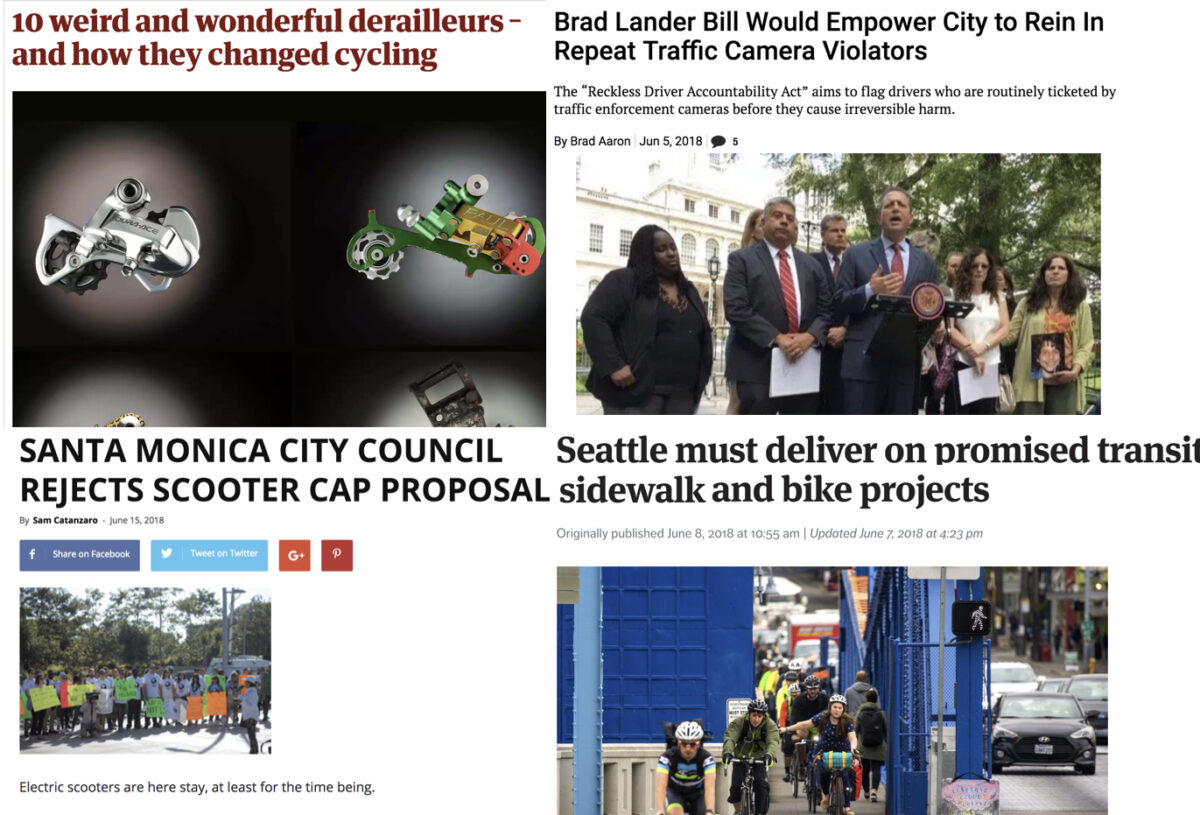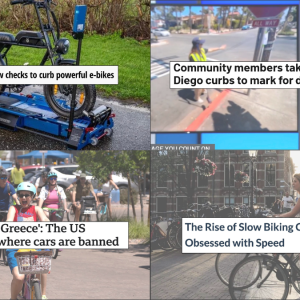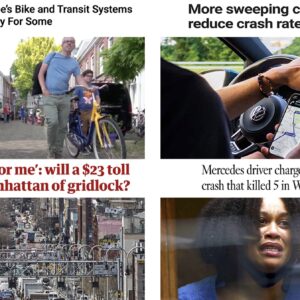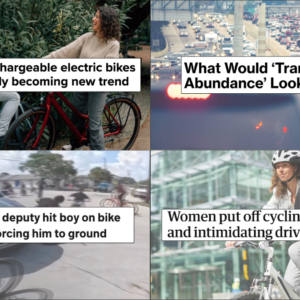Welcome to the week. Today’s Monday Roundup is made possible by Efficient Velo Tools: “Conceived, tested, and proven in Portland – the Safe Zone Helmet Mirror provides unparalleled protection.”
Here are the best things we found floating around the BikePortland universe in the past seven days…
Enough is enough: From carfree parks and plazas to protected bike lanes, New York City has led the way on many safe streets movements. Tougher regulations on dangerous drivers might be next. NYC Councilman Brad Lander has introduced the “Reckless Driver Accountability Act,” a bill that would proactively remove the worst offenders from the roads before they can kill and injure more people.
Cargo bike mothers: The Dutch city of Rotterdam is trying to attract young people and move past its industrial image. For better or worse, “cargo-bike moms” have become a symbol of the gentrification that has resulted.
Delightful derailleurs: A historical appreciation of an oft-unheralded yet vital part of most bicycles.
Bikes rule: A fascinating data and mapping breakdown of where, when, and why bikes are faster than taxis for 50 percent of peak-hour trips in Manhattan.
Inefficiency = inequality: A clear-sighted rebuttal from transit expert Jarrett Walker to the ridiculous notion that NYC should mothball its subways in favor of autonomous vehicles.
Crypto-cycling: To encourage use of its new range of e-bikes, this company pays riders about $25 worth of cryptocurrency for every 1,000 miles pedaled.
Advertisement
Hashtag insurrection: Streetsblog Denver reports that the Colorado DOT started a hashtag war with “SafetyStartsWithAllofUs,” and then transportation activists finished it.
Bad news in Washington state: The Columbian reports on Washington DOT’s latest stats that show the number of the number of people killed while walking or biking is up 60 percent from 2013. The state wants “Vision Zero” by 2030, but now officials say, “We have to struggle with the fact that we may not get to zero.”
Take an e-scooter for a ride: The Oregonian’s Portland-based transportation reporter Andrew Theen took a Lime electric scooter for a test ride.
Dockless in Santa Monica: As Portland preps to launch an e-scooter pilot, let’s learn from Santa Monica where they just announced a plan to allow four dockless companies (two e-scooter, two e-bike) to operate starting this fall.
Copenhagenizing: Need to sharpen your arguments about how biking can work in cities and dispel common myths? Don’t miss these charts and graphics from Mikael Colville-Andersen.
War on cars’ predictable pushback: We need more leaders like former Toronto planner Jennifer Keesmaat who aren’t afraid to say we need to be much tougher on auto use — if for nothing else than to urging local leaders to get back on track and make a stronger commitment to funding biking and walking projects.
Video of the Week: Check out this New Jersey resident who wanted a faster and more fun way to get to work in Manhattan. The answer? A folding bike and boat!
Thanks to everyone who sent in links this week.
— Jonathan Maus: (503) 706-8804, @jonathan_maus on Twitter and jonathan@bikeportland.org
Never miss a story. Sign-up for the daily BP Headlines email.
BikePortland needs your support.







Thanks for reading.
BikePortland has served this community with independent community journalism since 2005. We rely on subscriptions from readers like you to survive. Your financial support is vital in keeping this valuable resource alive and well.
Please subscribe today to strengthen and expand our work.
At first I was wondering why bikes were listed as faster than taxis for only 50 percent of rides — but then saw it was share bikes.
For personal bikes, I’d guess that number would be way higher.
The fast part of bike share is not on the street but where you put them. Lots of people don’t have safe/convenient/extant bike parking.
I’d love to see a map like that for Portland, separately in the morning and evening. As the Copenhagenize page demonstrates, most people bike because it is quick. In Portland, it is still way to easy and quick to drive from A to B than to bike.
From the Cargo Bike Mom article, my favorite parts was actually the “bakfietswijken” or cargo bike neighborhood. Perhaps we can designate some parts of Portland as Cargo Bike Neighborhoods too.
PDX bakfiets-wijken…or commercial bike freight streets… when will PBoT have a standards engineering detail for such? [To accommodate the widths and grades needed for SoupCycles, BLine, and UPS trishaws?]
If derailleur list is going to include designs that represent only aesthetic innovations (as it does), it really should also include hydraulic and electronic which are truly different.
Years ago I’d never have imagined gearing our tandem with a 52-42-30 and 40-11 cassette. Now, my stoker gets to synchro-shift to what she’s comfortable with – talk about a ‘back seat driver’! Tell me the RD-M9000 isn’t a work of art…
I do find it odd that for all the talk about how Shimano pretty much wiped out all the other brands, only a Dura Ace was shown, and not the oft-mentioned XT or the humble Deore. Shimano was simply cheaper, more durable, more compatible, easier to work on, usually lighter, and often even looked better, than Campy, Suntour, Sachs, etc.
Gentrification is a thing. Cargo bikes might be a signifier, but compared to other consumer items, not so much. A high-end cargo bike costs about as much, new, as a 10 year old sedan. It can be stored in 1/8 the space as a car. Operating cost is negligible, less than a dollar a day for steady year round use.
There aren’t many used cargo bikes for sale but give it a few years–the popularity of ebikes will push some older bakfiets into the market.
I would certainly prefer to have cargo bike moms than the monster truck moms we have in Beaverton.
I’m definitely seeing an uptick in the number of petite women driving massive trucks and SUVs. I cringe every time I see one.
I’m pretty sure the bike/boat commuter is a stunt. No way he does that on any regular basis.
I can believe this is a regular thing though it would take a dedicated person to use his setup.
He appears to be wearing immersion protection and an inflatable life vest which he’ll need if his boat gets swamped — that thing is going straight to the bottom since it lacks float bags but is hauling some heavy stuff. But he’d burn up wearing that gear anytime except on cold winter days even at an easy pace.
I’ve been tracking bike/boat commute scenarios for years and think it could be the best option for individuals with spectacularly bad or nonexistent bridge options since transitions are inherently problematic.
If there’s any way to secure a cheap kayak and bikes near the ends of the water segments, this would be a lot easier to do with two bikes and a boat (or bike share + boat)
Just wait till they close down the “L” train between Brooklyn and Manhattan for repair next year. This guy will be a rock star and will have many imitators as NYC has no other conceivable way to carry in excess of 100,000 that now ride the “L” Train. Plus the east river is a lot narrower than the Hudson this guy is crossing. People think the future will be personal helicopters and robot cars but this is probably it.
Why would it be a stunt? Obviously he’s not doing it purely for getting from Point A to B. He says he enjoys being on the water. And his setup for towing his boat is no different that what many people who surf have for getting to the water via bike.
A friend of mine commuted for over a year (until he moved out of town) by standup paddling from Willamette Park to Riverplace marina, where he kept a bike, and then biked to his Pearl District job (sometimes he skateboarded): https://www.youtube.com/watch?v=PUkFXMdZkLk
I used to have a Sevylor Colorado inflatable canoe and you could carry it and everything you need with you while walking and on the bus… I suspect it’d be a lot easier to put on a bike… you wouldn’t even need a trailer…
Not clear to me how the new “no parking” housing works for cargo bikes. Many bike rooms don’t accommodate cargo bikes and you can’t leave a $5,000 cargo bike sitting outside or carry it up to your apartment.
Thats True, If we are going to have real ,bakfietswijken, ( cargo bike neighborhoods) then we will need an ordinance requiring landlords to provide secure cargo bike parking as part of any apartment, no-parking or not. Many of these places have these big swanky common rooms that are only really used for pictures on the apartments website to trick prospective renters in to thinking the lavish common rooms are actually the postage stamp living rooms in the apartments they actually rent. Put these rooms to better use as cargo bike storage.
Yes secure inside bike parking is highly desirable. Though most Dutch baks are built for locking to a street rack and uncovered storage (marine plywood and metal chroming). [I did the same with my bak in Vancouver for years when I lived at an apartment.]
The reddit comments (translated from Dutch) about the Cargo Bike Mom article are a fun glimpse into a different world. Instead of SUVs killing people left and right, they complain about how the cargo bikes are aggressive and large and take too much parking space. Those would be nice problems to have! http://translate.google.com/translate?hl=en&sl=nl&tl=en&u=https%3A%2F%2Fwww.reddit.com%2Fr%2Fthenetherlands%2Fcomments%2F8qg2uj%2Fcargobike_moms_are_gentrifying_the_netherlands%2F%3Fst%3Djikrrtw4%26sh%3D98250e10&sandbox=1
I love the boat idea. Or ferries. Whatever happened to ferries?
In New York City they’re having ever more public money pumped into them (https://nyc.streetsblog.org/2018/05/03/de-blasios-ignorance-of-nycs-bus-crisis-shines-through-at-his-umpteenth-ferry-announcement/), while the rest of public transportation system crumbles.
It’s an interesting issue, but I’d rather much rather have the vehicles on the bridges.
In calculating the air pollution, you need to factor in getting on/off the ferry plus that many people will just idle vehicles for short rides and those that don’t will burn more fuel and generate more pollution when restarting.
Even downtown, the river is very nice during rush. I sometimes paddle it at night — there is no one out on the river at all. And there’s something fun about having nothing but space around you while everyone else is crammed together going nowhere fast. It’s very pretty in the dark.
Despite being an industrial river, the Willamette has some wildlife in it. Near downtown, I’ve encountered sea lions, beaver, an occasional otter, and of course the bird life (eagles, ospreys, wood ducks, etc). Even small motorboats that seem quiet on the surface make a heck of a lot of racket underwater that you can hear from far away. The big boats make an insane amount of noise. What’s puzzling to me is why there’s any wildlife at all. Moving thousands of cars using boats with massive smoke belching diesel engines that generate so much low frequency racket you can feel the sound waves does not sound fun.
In Venice they have public bus ferries, complete with ADA ramps, pre-pay boarding, and regular fixed-route schedules. They even look like TriMet buses, though a bit wider.
There’s talk of a new ferry route from Vancouver to downtown Portland… they claim it will be much faster than a driving commute.
Hello, Kitty tell me more as I missed this “recent”? news item. I would love to have that option…though it all depends on the top speed of the likely restricted travel speed (wakes). So far all the old studies I could find were pretty negative on a Portland CBD to Vancouver CBD ferry route as being the first option. (I actually think a Vancouver CBD to PDX North Airport terminal would be a great demo.)
2006 Ferry Study
https://www.portlandoregon.gov/bps/article/292730
I know Portland Spirit has been talking it up recently (within the last year or so). I don’t know how serious the idea is, but they claim travel time on the order of 30-40 minutes.
This would be a huge waste of money. Spend the money you would use to buy ferries and build docks and instead spend it to extend the yellow line over the river.
Even if the trip time on a ferry is slightly less than MAX, the realistic travel time is longer due to lack of frequency (MAX would be every 10-15 minutes, whereas a ferry would likely run once per hour). Ferries are hugely subsidized in most cities, typically 10x or more the subsidy per passenger than light rail or busses.
Might be useful during/after an earthquake?
Washington State Ferries is now outfitting & planning for e-Ferries with battery power…thus reducing the noise pollution and the mobile emissions issue.
This helps significantly with pollutants and noise, but the propellers themselves generate a lot more underwater racket than you’d think even if they’re really not bad on the surface. Don’t get me wrong. This is way better than internal combustion, but bridges are a good way to get people across rivers.
I often roll my boat when I’m on the river and am often astounded by what I can hear from how far away.
What about an unmotorized ferry? I mean, it’s just going across the river, after all. And I, like John, was thinking of ped/bike passengers only. I’m picturing a raft with passengers poling across…. 😉 But seriously–A Ben Hur deal? Electric motors? Willing porpoises?
PS. Though few building developers can or will set up Dutch style basement bike parking served with bike ramps…I have tried to suggest such recently on a few high density PDX buildings but the design trend is to not build high-rises with any sort of traditional basement, as I have ben told. So then these large bike rooms either take up all too valuable ground floor retail (thus squeezing their size down) or get pushed up onto residential floors (thus making it almost impossible to push a bak through elevator to hallways that often have 90 degree angles to reach the narrow <42 inch bike room doorway).
it’s not a “design trend”. expensive retail floor-space is a zoning requirement for many lots.
The “design trend” Todd is referring to is lack of usable basement, not inclusion of ground-floor retail.
Thanks, H-Kitty, for having my back[paw]! [You are correct per my poor attempt at communicating that point.]
Wouldn’t cargo elevators be a good fit for cargo bikes and bikes in general? Put the bike parking on the roof!
Yes…I guess the top floor could be a place to park a bak…do make sure that the cargo elevator is a “pass-thru” style with a door on opposite ends.
BUT I strongly doubt developers want to give the best views to bikes [penthouse parking] AND I doubt that bicyclists want to do a 2 elevator trip to get to their destination …or back to their bike.
Much easier and more convienant to use those street parking pods that lock, together with loJack and insurance.
The bike facilities I’ve seen on plans for commercial and multi-family project plans are often abysmal. They seem to be designed with no thought given to users, and more than the code-minimum number and sizes of spaces is rarely provided. The City staff approving them sometimes don’t even notice when the minimums are not provided. It makes me pessimistic about any projects accommodating cargo bikes.
But we’re against parking minimums, right? Won’t cargo bike parking just make rent more expensive?
Snark aside, I parked in bike rack at Memorial Coliseum recently that was tucked under a stair landing, and required me to tip my very normal sized bike sideways to reach the rack. If we can’t even get it right at our public buildings, what hope do we have to get Platinum again next year?
Ok, it wasn’t totally aside.
I wasn’t thinking so much about minimums, as about how people designing buildings often don’t seem to know how to design to accommodate bikes. Really, the process seems to be to check the zoning code table for how many need to be provided (again setting aside the question of whether there should be minimums) then look at the space diagrams in the code, then cram that many rectangles into a big rectangle which is then labeled “bike parking” on the plan. Then you locate that rectangle behind the garbage room or loading dock. And if you still have trouble fitting the required spaces in, you calculate how many spaces you’re short and write “17 (or whatever #) units have a bike hook within the unit”.
It’s much like designing for accessibility. People have no idea how to design for accessibility. They just look up the clearance diagrams in the code and put notes on the plans that match the clearance diagrams, and hope it gets approved.
I’ve heard it said (probably by me) that when you see bikes on apartment balconies, you know there has been a design failure. Unfortunately, I see a lot of bikes on balconies around town.
Not surprised Washingtonisn’t expected to make Vision Zero by 2030. We had a person killed crossing one of these 4-lane high speed roads here in Spokane a couple weeks ago, and our city council president basically stated, “things happen.” That kind of thinking does not get you near Vision Zero.
http://www.spokesman.com/stories/2018/jun/04/woman-dies-when-struck-by-van-in-downtown-spokane/
My wife kayaked from Willamette park to the boat docks near waterfront park and walked to work. She did it twice. Didn’t take her much longer than driving. Storing the Kayak was an issue.
She should be commended just for trying. For Cyril (the Portland paddler in the video) the training component was much more important than the commuting component. The decision to paddle-commute forced him onto the water twice per day, and gave him more time to train.
Cyril also had the storage and other logistics work out perfectly for him. I’d guess unconventional transportation has enough complications that it doesn’t make sense for most people unless they have a motivation beyond pure commuting (training, love of being on the water, etc.).